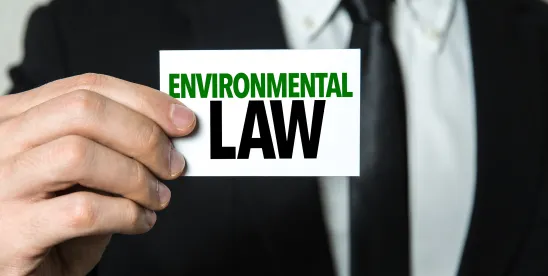The week of June 30, 2025, will go down in National Environmental Policy Act (NEPA) history as another one for the books — federal agencies have begun their efforts to overhaul their NEPA procedures and Congress has established a mechanism to guarantee expedited completion of NEPA analysis in return for a fee covering review costs. As always, the devil is in the details.
To recap, just since fall of 2024, implementation of the so-called “magna carta” of environmental laws has seen fundamental change. The White House Council on Environmental Quality (CEQ) rescinded its longstanding NEPA regulations, following the US Court of Appeals for the DC Circuit’s 2024 decision in Marin Audubon Society v. FAA concluding that CEQ did not have authority to issue those regulations. President Trump issued Executive Orders pertaining, in part, to narrowing NEPA reviews and directing agencies to use emergency procedures to permit energy projects. On February 19, 2025, CEQ issued guidance instructing federal agencies to review and revise their NEPA regulations and procedures in line with the statute itself, President Trump’s Unleashing America Energy Executive Order, and CEQ’s guidance. Then, the US Supreme Court issued its decision in Seven County Infrastructure Coalition v. Eagle County, which, in summary, scolded courts and agencies for excess NEPA analysis — just in time to play a key role in the agencies’ new NEPA procedures.
In the latest twist, Congress has jumped in with a provision in the Big Beautiful Bill (BBB). Under Section 112 of NEPA, as revised by the BBB, a project sponsor may provide CEQ with a description of the project and a notice that the sponsor intends to prepare the EA or EIS.[1] Within 15 days, CEQ will notify the sponsor of the amount of a fee that the sponsor can pay in return for the completion of an EA within 180 days of payment of the fee or an EIS within one year of publication of the Notice of Intent. The amount will be 125 percent of the anticipated cost of preparing the document. The agencies (and CEQ) will have to answer a variety of questions as this provision is implemented, such as how CEQ will staff this effort, how to set a fee, whether they can establish fees for categories of activities, how this provision will work where agencies already have applicants pay for NEPA-related work, whether agencies/applicants can negotiate an extension to the time period if needed, and whether this extra process will make a fundamental difference — especially with energy projects that are already subject to expedited procedures and for an EIS where agencies often frontload review prior to issuance of a Notice of Intent.
Turning back to Executive Branch action, many federal agencies, including but not limited to the US Department of the Interior (DOI), the US Army Corps of Engineers (USACE), the US Department of Defense (DoD), the US Department of Energy (DOE), the Department of Transportation (DOT), and the Federal Energy Regulatory Commission (FERC), have now (1) issued rulemakings revising and/or rescinding their own NEPA regulations; and (2) issued NEPA procedures or interim final regulations.[2]
Agency Approaches to Existing NEPA Regulations
Agencies like DOE and DOI issued Interim Final Rules (IFRs) rescinding their own NEPA regulations, except for certain sections relating to Categorical Exclusions, emergency circumstances, and third-party contractors. These agencies now intend to rely almost exclusively on the newly issued procedures to comply with NEPA. USACE, FERC, and DOT have each taken a slightly different approach. USACE also issued an IFR rescinding its own NEPA regulations but it took two different actions: (1) USACE announced it would rely on the DOD NEPA procedures for civil works purposes; and (2) USACE issued an IFR for the regulatory program that codifies NEPA procedures for permit applications submitted under various provisions, including Section 404 of the Clean Water Act, Section 10 of the Rivers and Harbors Act, and Section 408 of the Rivers and Harbors Act. FERC left its NEPA regulations in place but issued a final rule removing references to CEQ’s now-rescinded NEPA regulations. FERC also issued new NEPA guidance. DOT and its subagencies — the Federal Highway Administration, Federal Railroad Administration, and Federal Transit Administration — issued an IFR revising their NEPA regulations to account for the recission of CEQ’s regulations and recent statutory amendments to NEPA. DOT subsequently issued DOT Order 5610.1D, which provided the agency’s new NEPA procedures.
Many, but not all, of the agency IFRs and newly adopted procedures rely heavily on the Supreme Court’s decision in Seven County Infrastructure Coalition to explain the agencies’ intended approach to NEPA review.
Newly Issued NEPA Procedures
The procedures and regulations have several common elements and many that come directly from the statute. These elements include:
- A direction that agency staff should prepare an Environmental Assessment (EA) if the proposed action is not likely to have reasonably foreseeable significant effects or the significance of the effects is unknown, and prepare an Environmental Impact Statement (EIS) if the proposed action is likely to have reasonably foreseeable significant effects.
- A statement that both EAs and the EISs will: (1) focus on whether the environmental effects of the proposed action are significant, and (2) identify the scope of consideration of any environmental effects that extend outside the geographical territory of the project or might materialize later in time.
- With the exception of FERC, a statement that agencies have discretion to analyze environmental effects from other projects “separate in time, or separate in place” so long as the agency documents “where and how it drew a reasonable and manageable line” relating to its consideration of any environmental effects and it “would assist it in reasoned decision making.”
- A requirement that agencies comply with the time and page limits for EAs and EISs, as established in the Fiscal Responsibility Act’s amendments to NEPA, including: 75 pages and one year for an EA, and 150 pages and two years for an EIS, with a maximum of 300 pages allowed for extraordinarily complex EISs. These page limits do not include citations or appendices, and each agency must certify that they have made good faith efforts to comply with these limitations. Agencies are instructed to use appendices for only voluminous materials and data, which substantiate but do not expand upon the analysis.
- Each set of procedures provides that where emergency circumstances exist, the agency will consult with CEQ about alternative arrangements for compliance with NEPA.
- Each set of procedures contains a list of definitions defining key terms such as “Reasonably foreseeable” as “sufficiently likely to occur such that a person of ordinary prudence would take it into account in reaching a decision.”
While these recently issued procedures contain several common elements, significant differences exist amongst the agencies’ NEPA procedures.
- For example, DOE’s NEPA procedures contain a lengthy discussion of which “reasonably foreseeable environmental effects” require inclusion in the agency’s NEPA analysis. The agency’s procedures discuss the Supreme Court’s recent decision in Seven County Infrastructure Coalition v. Eagle County and conclude that the agency need only consider effects that “have a reasonably close causal relationship to the proposed agency action and alternatives.”
- Each set of procedures also differs regarding whether and when public comment is required. For example, FERC’s procedures state that the agency will provide a 45-day comment period for draft EISs and will allow comments from the public. In contrast, DOI’s procedures provide that the agency will accept comments from agencies and the applicant, but that the agency has discretion regarding whether to issue an EIS in draft form or whether to take public comment. Where DOI does accept comments, the procedures state that the agency will “seek to provide 30 days, to the extent practicable.”
- USACE’s regulatory program NEPA rule retains the codification of the agency’s longstanding approach to evaluating applications for permits where the agency’s regulatory hook is small relative to an overall project.
- DOI’s IFR alters the agency’s emergency permitting regulations at 43 CFR § 46.150(c), broadening the types of emergency situations that could qualify for the agency’s expedited procedures.
- Agency procedures also bring back some concepts that were present only in the CEQ regulations, and subsequent caselaw, but are not found in the statute.
The symmetries between the federal agencies’ approach to revising their NEPA procedures suggest that a significant effort has been made by CEQ to shepherd agencies towards a more streamlined, universal approach to NEPA. However, the asymmetry between the agencies predicts the need for a refined understanding of each agency’s new approach — and the need to iron out differences where multiple agencies are involved in one project.
[1] One Big Beautiful Bill Act, H.R. 1, 119th Cong., Sec. 60026 (2025).
[2] The referenced agency rulemakings and procedures are available online as follows:
- US Department of the Interior: https://www.doi.gov/oepc/national-environmental-policy-act-nepa;
- US Army Corps of Engineers: https://www.federalregister.gov/documents/2025/07/03/2025-12360/procedures-for-implementing-nepa-processing-of-department-of-the-army-permits; https://www.federalregister.gov/documents/2025/07/03/2025-12353/procedures-for-implementing-nepa-removal; https://www.denix.osd.mil/nepa/;
- US Department of Defense: https://www.denix.osd.mil/nepa/;
- US Department of Energy: https://www.energy.gov/nepa/office-nepa-policy-and-compliance;
- Federal Energy Regulatory Commission: https://ferc.gov/news-events/news/ferc-revises-nepa-procedures-make-permitting-more-efficient;
- US Department of Transportation: https://www.transportation.gov/sites/dot.gov/files/2025-07/DOT_Order_5610.1D_OST-P-250627-001_508_Compliant.pdf; and https://www.federalregister.gov/documents/2025/07/03/2025-12364/revision-of-national-environmental-policy-act-regulations; https://www.federalregister.gov/documents/2025/07/03/2025-12365/procedures-for-considering-environmental-impacts.





 />i
/>i

